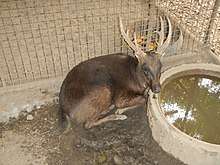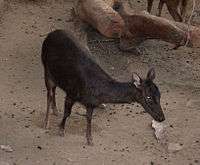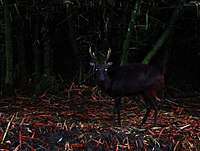Philippine deer
| Philippine brown deer | |
|---|---|
 | |
| Scientific classification | |
| Kingdom: | Animalia |
| Phylum: | Chordata |
| Class: | Mammalia |
| Order: | Artiodactyla |
| Family: | Cervidae |
| Subfamily: | Cervinae |
| Genus: | Rusa |
| Species: | R. marianna |
| Binomial name | |
| Rusa marianna (Desmarest, 1822) | |
| Synonyms | |
| |


The Philippine brown deer (Rusa marianna), also known as Philippine sambar or simply Philippine deer, is a species of deer endemic in the islands of the Philippines. It was first described from introduced populations in Guam and the Marianas Islands, hence the specific name. Currently, four subspecies are known which includes: R. m. marianna in Luzon biogeographic region, R. m. barandana in Mindoro, R. m. nigella in isolated upland areas of Mindanao, and R. m. nigricans in lowland sites of Mindanao [2]
Morphology
The Philippine brown deer is relatively smaller than its relative, sambar deer. Its head-and-body length and shoulder height measures 100 to 151 cm, and 55 to 70 cm, respectively. Its weight usually ranges from 40 to 60 kg. Generally, its color is brown with white tail underside. Antlers are common among males which measures 20 to 40 cm. Variations in morphology were observed especially in Mindanao populations, but is still unknown at present.
Geographic Range
This species occurs in most parts of the country except in the Negros-Panay, Babuyan/Batanes, Palawan, Sulu Faunal Regions and other disjunct islets.[3] Biliran, Bohol and Marinduque populations are believed to be extinct as a consequence of forest fragmentation.[4][5] Meanwhile, the deer has been declared to be extinct in Dinagat and Siargao Islands.[6][7] Across the country, its population is severely fragmented and reduced.
R. marianna was introduced to Guam by Mariano Tobias sometime around 1771 to 1772 to be used in recreational hunting. The deer subsequently populated other neighboring locales in Micronesia, including the islands of Rota, Saipan and Pohnpei. However, in the absence of a natural predator, its population is rapidly expanding in Guam, posing serious threats to the native ecosystem and agricultural lands due to overgrazing. Hence, management programs are imposed to significantly reduce the deer population.[8] In addition, there have been reports of introduction in Ogasawara Islands, Japan during the late 18th and 19th centuries, which immediately went extinct in 1925. A population from Guam was re-introduced after World War II, but followed the same fate years later.[9]
Habitat and Ecology
The Philippine brown deer generally thrives in a terrestrial environment from sea level up to at least 2,900m. They prefer to forage in grasslands under primary and secondary forests.[10][11][12][13] However, due to forest denudation and excessive hunting, they are driven uphill to hide in the remaining patches of forests. They are generally nocturnal which means that they look for food: grasses, leaves, fallen fruits and berries at night. During daytime, they rest in the dense forest thickets. Mating season is usually between September to January. During this time, females organize in small groups composed of at most eight (8) individuals, while males are solitary and are aggressive. After approximately six (6) months, females give birth to a single fawn with light-colored spots that eventually disappear after several weeks.[14]
Philippine brown deer as a cultural keystone
The Bagobo-Tagabawa tribe in Barangay Sibulan, Toril, Davao City identified the Philippine brown deer as a "cultural keystone species" (CKS). This means that the deer plays a vital role in their culture. As a matter of fact, tribesmen claimed that their tribe would be incomplete if without the deer. To preserve their cultural pride by avoiding over-hunting, the tribe has declared hunting and non-hunting zones in the forest.[15]
Conservation status
The deer was rare (R) in 1994, data deficient (DD) in 1996, and vulnerable (VU) since 2008 up to present. This is because of the rapid population decline estimated to be more than 30% in the last 24 years or three generations due to excessive hunting, shrinkage in distribution, and habitat loss and fragmentation.[16]
Threats
There are several threats that contribute to the rapidly declining population of the Philippine brown deer. Habitat loss and fragmentation drive the deer to hide in the remaining patches of forest with scarce food to eat. While they forage in grasslands, the deer prefer forest shade as hiding places, especially during daytime. The deer also has low fertility, giving birth to a single fawn in each conception. This means that excessive hunting has a high tendency of declining their population. The deer is hunted for meat, usually sold at PhP150-250 per kilogram. Ethnoecological evidences also reveal that the antler of the deer aside from being a common household decoration, is also used to treat stomach ache, tooth ache, fever, etc. This is done by scratching the surface of the antler with a sharp object (e.g. knife), then adding the powder into a glass of water before drinking.[17]
See also
References
- ↑ Oliver, W.; MacKinnon, J.; Ong, P. & Gonzales, J.C. (2008). "Rusa marianna". IUCN Red List of Threatened Species. Version 2008. International Union for Conservation of Nature. Retrieved 8 April 2009. Database entry includes a brief justification of why this species is of vulnerable.
- ↑ MacKinnon, J.R., Ong, P. & Gonzales, J. 2015. Rusa marianna. The IUCN Red List of Threatened Species 2015: e.T4274A22168586. https://dx.doi.org/10.2305/IUCN.UK.2015-2.RLTS.T4274A22168586.en
- ↑ Oliver, W.L.R., Dolar, M L. and Alcala, E. 1992. The Philippine spotted deer, Cervus alfredi Sclater,conservation program. Silliman Journal 36: 47-54.
- ↑ Rickart, E.A., Heaney, L.R., Heidman, P.D. and Utzurrum, R.C.B. 1993. The distribution and ecology of mammals on Leyte, Biliran, and Maripipi islands, Philippines. Fieldiana: Zoology 72: 1-62.
- ↑ Oliver, W.L.R., Dolar, M L. and Alcala, E. 1992. The Philippine spotted deer, Cervus alfredi Sclater,conservation program. Silliman Journal 36: 47-54.
- ↑ Heaney, L.R., Balete, D.S., Dollar, M.L., Alcala, A.C., Dans, A.T.L., Gonzales, P.C., Ingle, N.R., Lepiten, M.V.,Oliver, W.L.R., Ong, P.S., Rickart, E.A., Tabaranza Jr., B.R. and Utzurrum, R.C.B. 1998. A synopsis of the mammalian fauna of the Philippine Islands. Fieldiana: Zoology (New Series) 88: 1–61.
- ↑ Heaney, L.R., Gonzales, P.C., Utzurrum, R.C.B. and Rickart, E.A. 1991. The mammals of Cataduanes Island: Implications for the biogeography of small land-bridge islands in the Philippines. Proceedings of the Biological Society of Washington 104(2): 399-415.
- ↑ Wiles, G., Buden, D., & Worthington, D. (1999). History of introduction, population status, and management of Philippine deer (Cervus mariannus) on Micronesian Islands. Mammalia, 63(2). doi:10.1515/mamm.1999.63.2.193
- ↑ Miura, S. and Yoshihara, M. 2002. The fate of Philippine brown deer Cervus mariannus of the Ogasawara Islands, Japan. Mammalia 66: 451-452.
- ↑ Taylor, E.H. 1934. Philippine land mammals. Manila.
- ↑ Sanborn, C.C. 1952. Philippine Zoological Expedition 1946-1947. Fieldiana: Zoology 33: 89-158.
- ↑ Rabor, D.S. 1986. Guide to the Philippine flora and fauna. Natural Resources Management Centre. Ministry of Natural Resources and University of the Philippines.
- ↑ Heaney, L.R., Balete, D.S., Dollar, M.L., Alcala, A.C., Dans, A.T.L., Gonzales, P.C., Ingle, N.R., Lepiten, M.V.,Oliver, W.L.R., Ong, P.S., Rickart, E.A., Tabaranza Jr., B.R. and Utzurrum, R.C.B. 1998. A synopsis of the mammalian fauna of the Philippine Islands. Fieldiana: Zoology (New Series) 88: 1–61.
- ↑ MacKinnon, J.R., Ong, P. & Gonzales, J. 2015. Rusa marianna. The IUCN Red List of Threatened Species 2015: e.T4274A22168586. https://dx.doi.org/10.2305/IUCN.UK.2015-2.RLTS.T4274A22168586.en
- ↑ Villegas, J.P. 2017. The Tree Horn: A Story of the Philippine Brown Deer (Rusa marianna)
- ↑ MacKinnon, J.R., Ong, P. & Gonzales, J. 2015. Rusa marianna. The IUCN Red List of Threatened Species 2015: e.T4274A22168586. https://dx.doi.org/10.2305/IUCN.UK.2015-2.RLTS.T4274A22168586.en
- ↑ Villamor, C.I. 1991. Deer captive breeding practices at a glance. Canopy International (Philippines):10–12.
